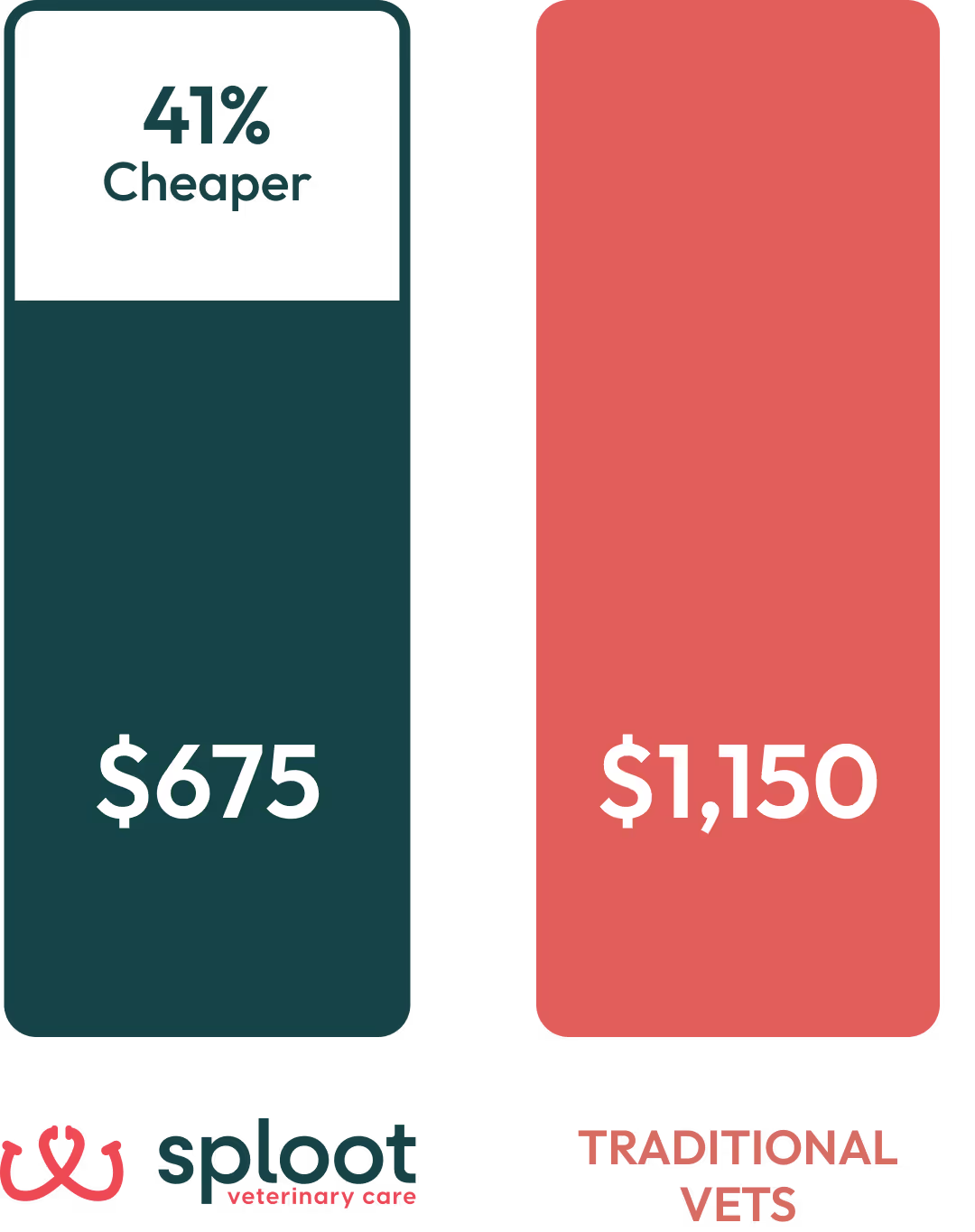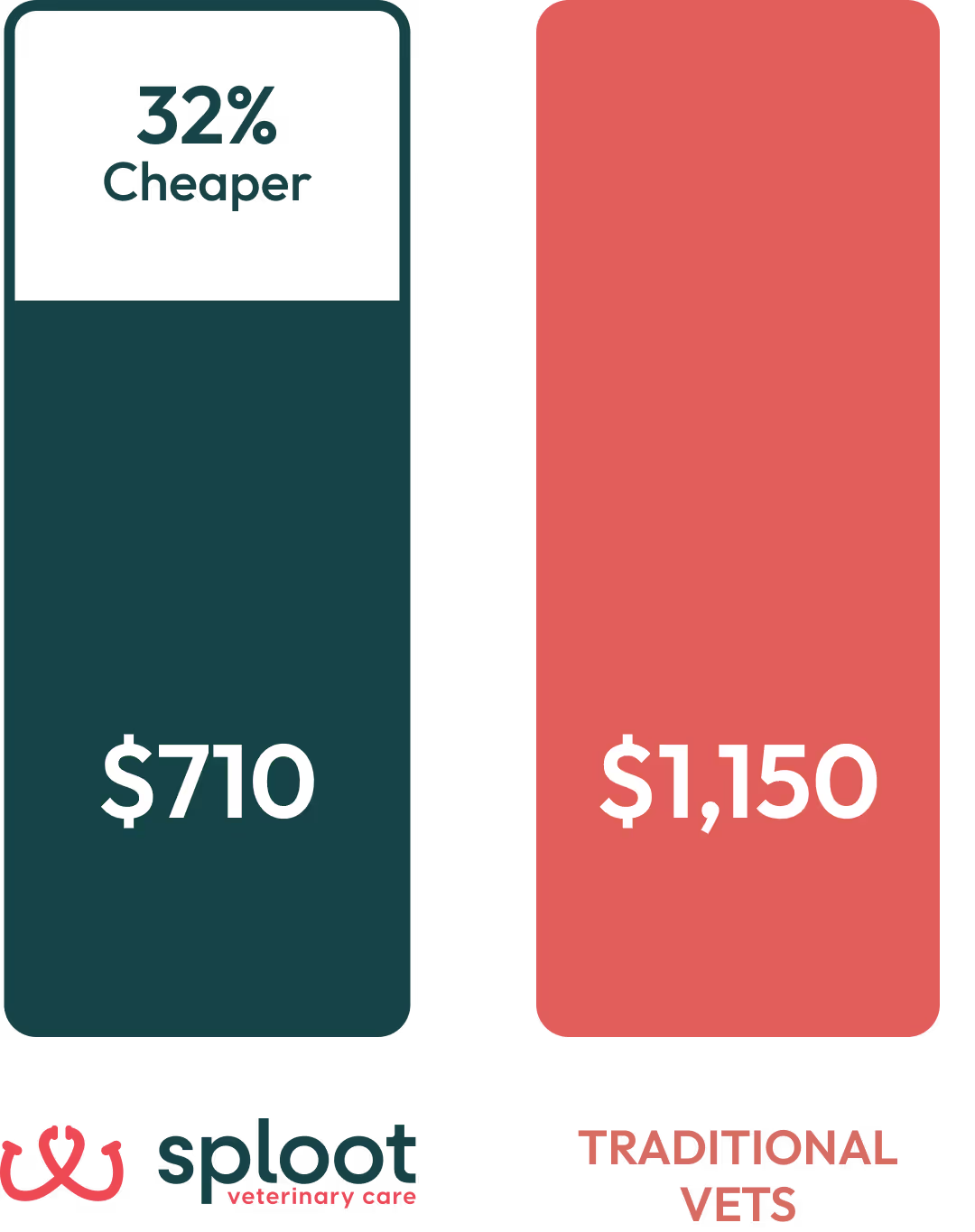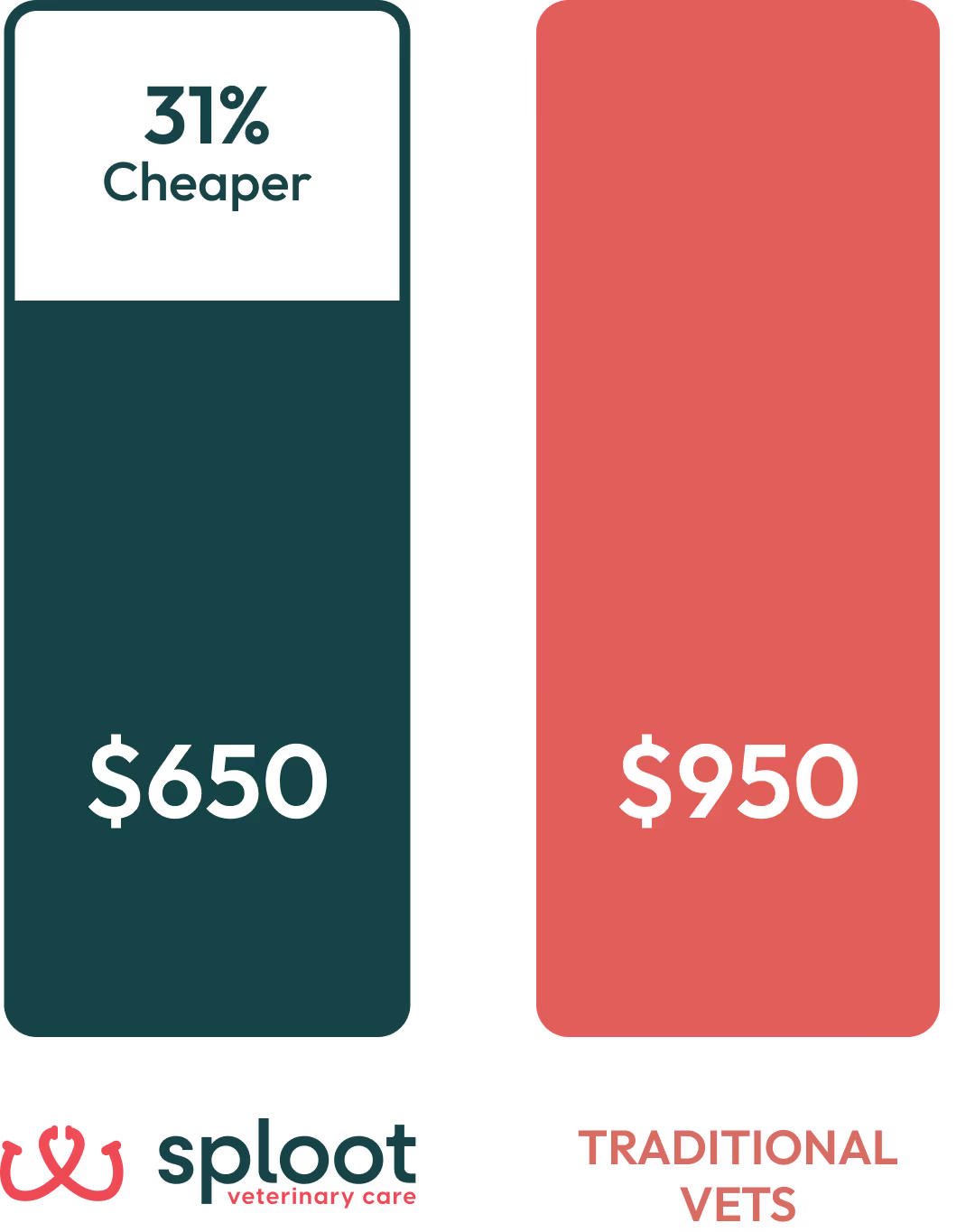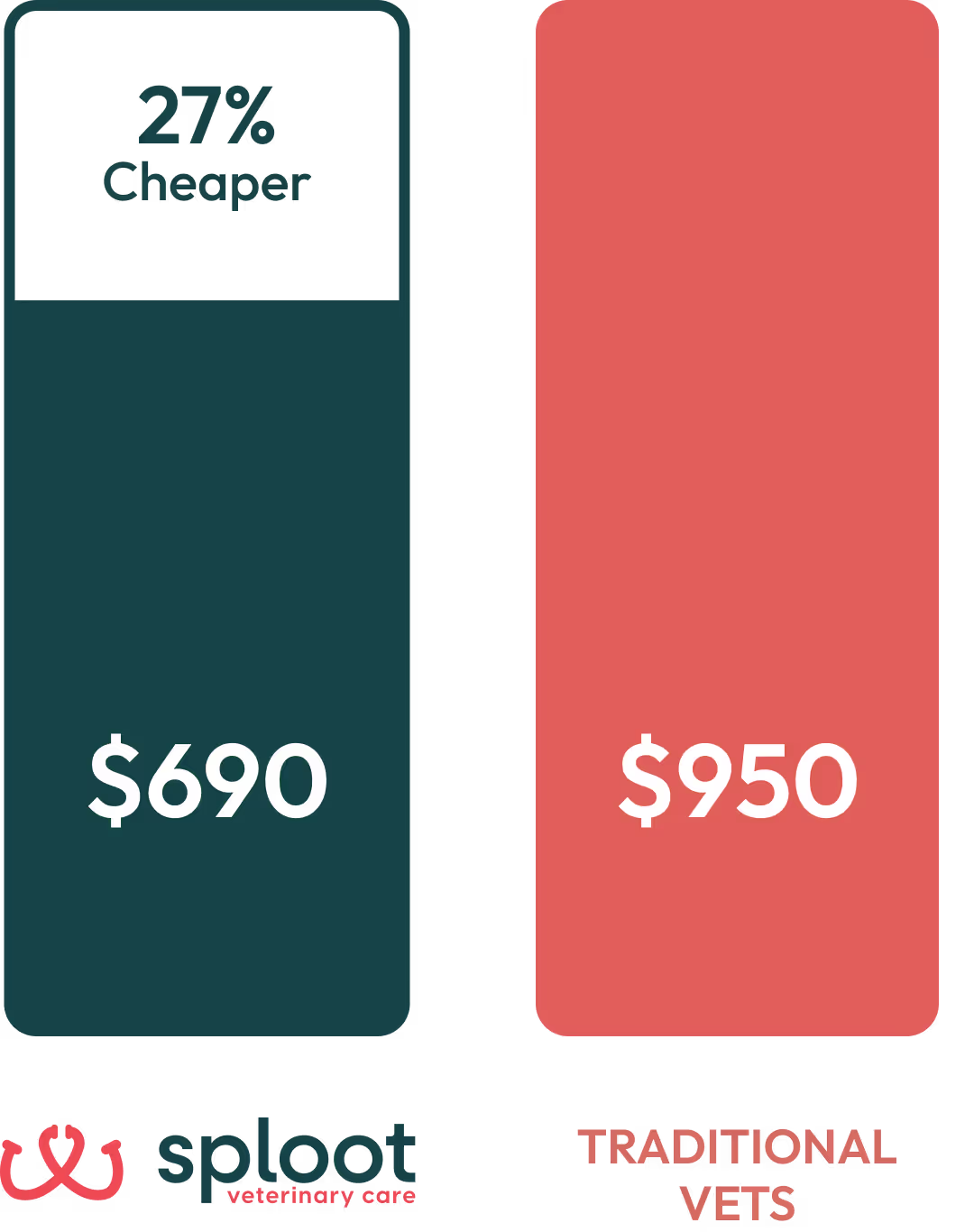
Pet Dental Care
Did you know that dental care is crucial for more than just fresh breath? Regular dog teeth cleaning and cat teeth cleaning prevent plaque buildup, infections, and tooth loss. Poor dental health can lead to serious health problems, including heart, liver, and kidney disease. Scheduling regular pet dental checkups can help extend your pet’s lifespan and improve their overall well-being.
Why is Dental Care for Pets Important?
- Dental cavities or tooth decay
- Bacterial infections
- Gingivitis (inflammation of the gums)
- Periodontal gum disease (impacts the heart, liver, & kidneys).

Premium Pet Dental, Minus the Premium Price
💡Includes procedure, pre-op exam, and bloodwork
🛡️No hidden fees. Just expert care + full transparency.
Pricing reflects the average cost of a feline dental in Sploot’s market. Traditional vet pricing is based on the average minimum cost across 10+ local clinics, including consultation, bloodwork, and procedure. Sploot pricing represents the starting rate for SplootPack members and also includes consultation, bloodwork, and procedure.

Save big with SplootPack membership
That’s $600+ in savings— and the membership basically pays for itself before the year even begins.
Pricing reflects the average cost of a canine dental in Sploot’s market. Traditional vet pricing is based on the average minimum cost across 10+ local clinics, including consultation, bloodwork, and procedure. Sploot pricing represents the starting rate for SplootPack members and also includes consultation, bloodwork, and procedure.

Save big with SplootPack membership
That’s $600+ in savings— and the membership basically pays for itself before the year even begins.
Pricing reflects the average cost of a feline dental in Sploot’s market. Traditional vet pricing is based on the average minimum cost across 10+ local clinics, including consultation, bloodwork, and procedure. Sploot pricing represents the starting rate for SplootPack members and also includes consultation, bloodwork, and procedure.

Save big with SplootPack membership
That’s $600+ in savings— and the membership basically pays for itself before the year even begins.
Pricing reflects the average cost of a canine dental in Sploot’s market. Traditional vet pricing is based on the average minimum cost across 10+ local clinics, including consultation, bloodwork, and procedure. Sploot pricing represents the starting rate for SplootPack members and also includes consultation, bloodwork, and procedure.

Save big with SplootPack membership
That’s $600+ in savings— and the membership basically pays for itself before the year even begins.
Why Choose Sploot for Your Pet’s Dental Care

A full health evaluation, including bloodwork and pre-anesthesia checkups, to ensure your pet is fully prepared for the procedure.

With your pet under anesthesia, we can safely and effectively clean both above and beneath the gumline. This allows for a complete cleaning and the use of X-rays to detect any hidden dental issues.

Our cutting-edge dental X-ray technology and dental tools help us identify hidden issues such as fractures, abscesses, and bone loss to ensure your pet’s mouth is in optimal health.

Your pet receives one-on-one monitoring throughout recovery, advanced pain management with Nocita, and clear aftercare instructions for a smooth and speedy recovery.
Regular veterinary dental care, along with a consistent at-home care routine, helps prevent pet dental issues. Take the next step towards better pet dental health today!
WHAT TO EXPECT
We use the latest techniques and state-of-the-art equipment to ensure that your pet receives the highest quality of care.
Dental care at Sploot includes the following: consultation, dental exam, and dental cleaning. Dental surgery will be prescribed as needed, depending on the findings during the consultation and dental exam.

Consultation
• Check if your pet is in good health to undergo anesthesia (bloodwork will be conducted); and
• Provide an estimate (this may be updated later after the dental exam, which allows the veterinarian to more thoroughly examine the pet’s oral health)


Dental Exam & Teeth Cleaning
Dental Surgery (As Needed)
• Gingivectomy - For managing advanced gum disease (periodontal disease)Oral mass removal - For oral mass diagnosis and removal
.webp)
Anesthetic Dental is the Gold Standard
Anesthetic Dental Procedures: The Gold Standard for Your Pet
At Sploot, we use anesthetic dental cleanings to ensure a safer, more thorough procedure that protects your pet’s long-term dental health
Book Your Pet’s Gold Standard Dental Care Now

Financing Made Simple for Pet Care
We accept the CareCredit credit card to help you pay over time for your pet’s care — from routine checkups to unexpected procedures*.
At Sploot, we know pet healthcare expenses can come at unexpected times. That’s why we accept the CareCredit credit card, a flexible financing solution to help you manage the cost of veterinary care. Whether it’s diagnostics, dental work, or emergency treatment, CareCredit allows you to pay over time with promotional financing options on purchases of $200 or more.
WHY SPLOOT VETS?
All Under
One Woof™

Next-Level
Vet Care
Vet Care
When You Need It
Exceptional Pet &
Parent Experience
At-Home Pet Dental Care Tips
Complete pet dental care starts at home. Here are steps you can take to help prevent dental issues in dogs and cats.:
%20(1).webp)
Brush daily using a pet-safe toothbrush and toothpaste to prevent plaque buildup
Provide dental chews that help clean teeth and freshen breath.
Use water additives to reduce tartar and promote healthy gums
Regularly inspect your pet’s mouth for signs of discolored teeth, inflamed gums, or bad breath. Schedule a veterinary dental exam at least annually and when symptoms arise.
Regular pet dental care can prevent serious health issues down the road.

When to See a Vet for Pet Dental Care
mouth
Ready to give your pet stress-free dental care?
FREQUENTLY ASKED QUESTIONS

Regular dental care for pets is important because it helps avoid dental disease. After a cat or dog’s first year of life, tartar and plaque begins to appear which, if left unaddressed, can lead to tooth cavities, gingivitis, periodontal disease, and etc.
It is important to note that periodontal disease does not solely impact the gums and teeth; in advanced stages, it can lead to systemic or organ damage.

Common signs of dental problems in dogs and cats include difficulty eating, bad breath, bleeding gums, drooling, and chewing food solely on one side of the mouth. Dental problems may also involve tooth abnormalities that may be visible upon a closer look at the pet’s teeth. Teeth may appear broken, moving, retained, or discolored.

Though less common than in humans, dogs and cats can get cavities too. In fact, this is one of the most common dental issues observed in pets. Tooth cavities or tooth decay in dogs and cats are caused mainly by acidic plaque buildup which creates holes on the tooth’s protective layer, the enamel.

The best way to prevent dental problems in dogs and cats is to brush their teeth regularly at home and provide dental chews or toys. Make sure to only use products that are safe for pets. Our veterinarians can give recommendations on which products are the safest and most effective to use.
In addition, scheduling regular dental exams and tooth cleanings is highly recommended to address dental issues early on and prevent plaque buildup.

Generally, cats need annual dental exams after reaching their first year of life. Meanwhile, dogs need annual dental exams after reaching two years of age.

Veterinarians perform a dental consult exam to know if a dog or cat needs dental cleaning.

Pet parents are encouraged to brush their pet’s teeth at home using products designed to be safe for dogs and cats. However, this does not take the place of professional teeth cleaning done by veterinarians which is more thorough and addresses the issue of tartar and plaque build-up.

Dental cleaning involves the use of specialized instruments to remove plaque and tartar from the cat or dog’s teeth while the pet is under anesthesia. This process comes after a thorough dental examination that assesses the condition of the teeth and gums. If necessary, dental procedures like dental extractions are done after dental cleaning.

Generally, it is recommended for dogs and cats to undergo dental cleaning once a year. However, the frequency of dental cleanings depends on the individual needs of the cat or dog. Our veterinarian can recommend the appropriate frequency of dental cleaning for your pet's needs.

Dental cleanings are generally safe for pets, but there is a very small risk of complications from anesthesia. Consult your veterinarian or our Pet Parent Concierge Team if you have concerns about anesthesia (which is mandatory for all dental exams at Sploot).

Dental exams and teeth cleaning for dogs and cats require the use of anesthesia to ensure a stress-free and safe experience for pets.
Anesthesia-free dental cleaning is not just stressful for pets, it also comes with increased risks — such as that of injuries to the pet and the accidental aspiration of debris (which can result in serious complications.)
Anesthesia-free cleaning is also not as thorough as professional dental cleaning with the aid of anesthesia.

Yes. When used by a professional, anesthesia is safe. Here at Sploot, we do a pre-operative examination and lab work to ensure utmost safety for pets of all ages. If for any reason your pet is deemed to be too high risk for anesthesia, our veterinary team will discuss other ways to help.

We do not take anesthesia lightly in patients of any age, and certain precautions should be taken for senior pets. Our highly skilled veterinary staff will do a pre-operative assessment and use state-of-the-art monitoring equipment to make sure your pet is in the best of hands.

Senior pets and pets with underlying health issues can still receive dental care, but special precautions may need to be taken. Our veterinarians can provide guidance on the best approach for your pet.

All in all, routine dental exams and teeth cleaning typically take around 2 hours. The time needed for other dental procedures depends on the extent of the dental issue(s) being addressed.

No. Dental care spans two visits for several reasons.
During the first visit, our veterinarians perform a physical exam and bloodwork to ensure that the cat or dog is healthy enough to be given anesthesia.
During the second visit, the dental exam (including any necessary dental radiography), dental cleaning, and needed dental procedures (e.g. tooth extraction) are done — all while the dog or cat is under anesthesia. The second visit must take place at least 24 hours after the initial visit, in order to have sufficient time to receive the results of bloodwork and to ensure the pet has had adequate time to fast in advance of undergoing anesthesia.

In case a dental issue cannot be addressed within the clinic, the pet parent will be given a referral for specialist care.

Periodontal disease in pets is a progressive bacterial disease that affects the teeth, gums, and bone. Visible signs of periodontal disease may not be present until the disease is in its advanced stages. This is why having a preventive approach against dental issues is highly recommended.

According to the American Veterinary Medical Association, periodontal disease is the most common dental condition in dogs and cats. The likelihood of periodontal disease increases once a pet reaches three years of age. This is why preventive dental care is recommended at an early age and onward.

Periodontal disease is typically treated with a combined approach including professional dental cleaning, prescribed antibiotics, and home care. Tooth extractions may be needed in severe cases.
It is important to note that advanced periodontal disease in pets, wherein bone loss has occurred, can be managed but is no longer considered curable.

You can choose to schedule an appointment with Sploot Vets hours, days, or weeks in advance. We also accept same-day appointments and urgent drop-offs (drop-offs)!

For the safety of our clients and our clinics, we only accept cashless payments. We gladly welcome all major credit and debit cards, along with financing through CareCredit and ScratchPay.

Pet parents can be reimbursed by their insurance plan as long as the treatment falls within the plan’s coverage scope.
It's important to note that the scope of veterinary services covered by pet insurance providers vary. Contact your provider if you have questions about covered treatments in your insurance plan.

Dental Surgery for Advanced Care
.avif)
Got Questions? Call or Text!
Whether you’d like to learn more about our dental services, or just consult our Pet Parent Concierge Team on next steps, you can call or text us!
Ready for Exceptional Veterinary Care?
We accept scheduled appointments, same-day appointments, & urgent drop-offs at ALL our clinics.















